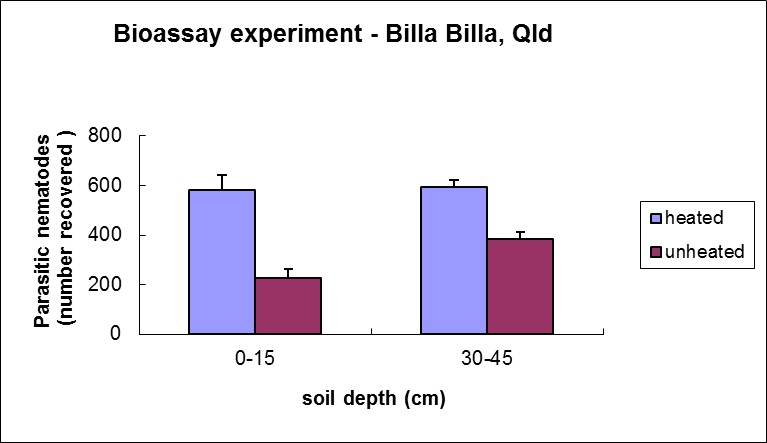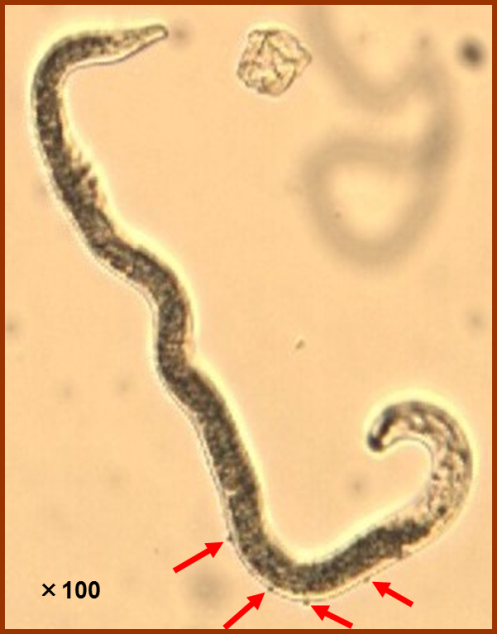Biological suppression of root lesion nematodes in northern grain growing soils
Biological suppression of root lesion nematodes in northern grain growing soils
Author: Nicole Seymour (Queensland Department of Agriculture and Fisheries), Graham Stirling, Jady Li | Date: 01 Mar 2016
Take home message
- Biological suppression does occur in most soils we tested from the northern grain-growing region, showing that populations of P. thornei are being reduced by parasites and predators.
- Suppression was found to be greater in the top 10cm of soil than at deeper layers (e.g. 30-45 cm). Practices such as zero tillage with stubble retention enhanced suppression. Without these practices, we estimate that RLN multiplication would be significantly greater, especially in top soils, and this would result in much greater losses in the productivity of susceptible crops.
- Several antagonists of Pratylenchus were found in northern grain-growing soils such as nematode trapping fungi, predatory nematodes, parasitic bacteria and root-colonising fungi that enhance the plant’s resistance to nematodes. Further research is focussing on these organisms as they are likely to be contributing to the suppressiveness of the soils.
Root-lesion nematodes (Pratylenchus thornei and P. neglectus) cost Australian growers in excess of $250 million/annum. Control of this pest relies on an integrated management program that includes the use of tolerant or resistant varieties, crop rotation and good farm hygiene, but even then costs to production can be high. Enhancing the suppressiveness of soil to root-lesion nematodes is a control option that deserves some consideration. Disease suppression is defined as the ability of a soil to suppress disease incidence or severity even in the presence of the pathogen, host plant and favourable environmental conditions. The vast array of organisms in the soil can provide a degree of biological buffering against pathogens. Disease reduction results from the combined effects of many antagonists acting collectively and mediated through inputs of organic matter (general suppression) and direct antagonism by a limited number of organisms (specific suppression) .
A recent GRDC-funded project aimed to better understand the suppressive nature of grain-growing soils and provide growers with methods to enhance suppressiveness of their soils to root-lesion nematodes.
Over 4 years, a total of 24 different sites were sampled to test the suppressiveness of the soils. This included several farmer paddocks and 3 long-term farm management trial sites with several fertiliser or tillage treatments. Also, seven of the sites were comparisons of cropped and pasture or native/scrub remnant soils that were in close proximity to gain an understanding of the impact cropping may have on suppressiveness to root-lesion nematodes.
Repeated studies over 4 years of multiple soils from northern NSW and southern Qld consistently showed general suppressiveness to root-lesion nematodes does exist in a variety of soils. In glasshouse tests, we also found that a 10% addition of suppressive field soil to a sterilised soil (heated at 60oC for 45 mins) is sufficient to reduce RLN multiplication by 60-90%, showing that the suppressive effect was biological and could be transferred or added to a less suppressive soil.
Table 1. Final Pratylenchus thornei numbers in a glasshouse pot-based suppression assay for soil from three different sites (Numbers followed by the same letter within each site are not significantly different P = 0.05)
|
Site |
Final P. thornei population (nematodes/g soil) |
||
|
Sterilised soil |
Unsterilised soil |
Sterilised + 10% unsterilised |
|
|
Hermitage Fallow Management trial, Warwick, Qld |
86 a |
12 b |
12 b |
|
Billa Billa, Qld (ex-wheat and remnant scrub soil) |
71 a |
18 b |
24 b |
|
Billa Billa, Qld (ex-sorghum soil) |
89 a |
21 b |
25 b |
|
Colonsay fertiliser trial, Norwin, Qld |
66 a |
24 b |
53 a |
General suppression of plant parasitic nematodes was also found to be much greater in soil from 0-15cm than soil from lower in soil profile. The figure below indicates that there are less plant parasitic nematodes at 0-15cm (coinciding with the higher levels of microbial populations) and that heating removes the microbial community and hence the suppressive effect.

Figure 1. Results of one bioassay on a soil from a cropped (wheat/sorghum) paddock from Billa Billa showing that biological suppression of parasitic nematodes (difference between numbers recovered after adding nematodes to the heated and unheated soils) is greater in the 0-15cm layer of soil than in the 30-45 cm layer
Surveys of over 130 soils from the northern region found a range of natural enemies that could suppress RLN. These included Pasteuria, a bacterial parasite (found in 25% of soils), nematode-trapping fungi (in 42% of soils) and predatory nematodes (in 77% of soils). Of the 25% of grain-growing soils where root lesion nematodes and Pasteuria spp. were present, only 6% of the RLN population were infected. This bacterium has the potential to infest and kill root-lesion nematodes but populations appear too low to currently be having any great impact. More study is required to better understand the lifecycle and ecology of this highly specialised parasite as prior to this project, it had never been previously observed in Australia on Pratylenchus thornei .

Figure 2. Root-lesion nematode (Pratylenchus thornei) infested with parasitic bacteria (Pasteuria sp.) as indicated by the red arrows.
Four different species of nematode-trapping fungi were found in 26 different soils from the northern region using traditional isolation techniques. A method was also developed to detect these fungi using DNA extraction from soil (DAQ00164/ DAV00105 collaboration).
The addition of a fungal endophyte (Fusarium nygamai) previously isolated from wheat roots growing in a soil from a property near North Star, NSW reduced P. thornei multiplication by 40% in a pot assay. More studies are required to confirm these results and determine whether this fungus is a potentially useful biocontrol organism. Several other endophytic fungi were isolated from roots but are yet to be tested for suppressive activity. Overseas work has shown that the presence of endophytic strains of Fusarium in roots enhance the plant’s capacity to defend itself from nematode attack.
Key farm practices that may enhance suppressiveness to root-lesion nematodes were examined. A field trial at Hermitage Research station, near Warwick, Qld, was specifically designed to study the impact of organic amendments (0, 5, 10 and 20 t organic matter/ha, incorporated into the top soil on application) and various cropping regimes (continuous fallow, sorghum with residue retained, sorghum with no residue retained) on RLN (P. thornei) multiplication in wheat grown after these treatments. In the first year, we found more beneficial nematodes and lower RLN numbers in surface soils, only in the highest organic matter treatment and where sorghum was grown and stubble was retained. Two and three years later, these earlier seen increases in suppression were not as evident and did not affect crop yield. However improved soil biology, especially in the surface soils, was still present when soil was cropped continuously compared to fallow. The trial showed that intensive cropping is more influential on RLN suppressiveness than addition of up to 20t/ha of organic matter. Soil chemical and physical differences measured did not appear to influence suppressiveness significantly and fertiliser (N, P) applications did not alter suppressiveness.
Implications
Suppression does occur in most soils we tested from the northern grain-growing region showing that populations of P. thornei are being reduced due to biological activity. Suppression was found to be greater in the top 10cm of soil than at deeper layers (e.g. 30-45 cm), and practices such as zero tillage with stubble retention enhanced suppression.
Maintenance of a healthy topsoil through diverse organic matter inputs will preserve the suppressive potential of soils against RLN.
Heavy rates of stubble (up to 20t/ha) increased general suppression of RLN in the short term. This coincided with high levels of microbial activity.
The presence of a crop for longer periods of time and the associated input of root exudates may have provided a better environment for sustained microbial activity and hence suppression of RLN.
Growers using no-till, stubble retention practices and cropping when soil moisture allows are probably doing a great deal toward enhancing the suppressiveness in their top soil. Without these practices, we estimate that RLN multiplication would be significantly greater especially in top soils and therefore lead to much greater losses in productivity of susceptible crops.
More work is required to confirm the biological control agents found to be present in our grain-growing soils can have a significant impact on RLN populations on a broad-scale.
Acknowledgements
The research undertaken as part of this project is made possible by the significant contributions of growers through both trial cooperation and the support of the GRDC, the authors would like to thank them for their continued support.
Contact details
Nikki Seymour
Department of Agriculture and Fisheries
Leslie Research Facility, Toowoomba
Ph: 07 46398837
Fx: 07 46398800
Email: Nikki.seymour@daf.qld.gov.au
GRDC Project Code: DAQ00164,
